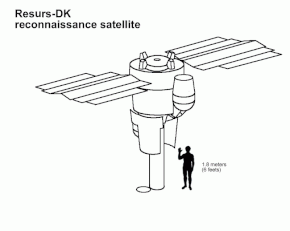 | |
| Names | Resurs-DK1 |
|---|---|
| Mission type | Earth observation |
| Operator | NTs OMZ |
| COSPAR ID | 2006-021A |
| SATCAT no. | 29228 |
| Website | eng |
| Mission duration | 3 years (planned) [1] 9 years, 7 months, 22 days (achieved)[2] |
| Spacecraft properties | |
| Bus | Yantar[3] |
| Manufacturer | TsSKB-Progress |
| Launch mass | 6,570 kg (14,480 lb) [1] |
| Payload mass | 1,200 kg (2,600 lb) |
| Dimensions | 7.93 × 2.72 m (26.0 × 8.9 ft) |
| Start of mission | |
| Launch date | 15 June 2006, 08:00:00 UTC[4] |
| Rocket | Soyuz-U |
| Launch site | Baikonur, Site 1/5[5] |
| Contractor | TsSKV-Progress |
| End of mission | |
| Disposal | Decommissioned |
| Deactivated | 7 February 2016 [2] |
| Orbital parameters | |
| Reference system | Geocentric orbit[6] |
| Regime | Low Earth orbit |
| Perigee altitude | 555.74 km (345.32 mi) |
| Apogee altitude | 566.46 km (351.98 mi) |
| Inclination | 69.94° |
| Period | 95.88 minutes |
| Instruments | |
| Geoton-1 PAMELA ARINA | |
Russian Earth observation | |
Resurs-DK No.1,[7] also called Resurs-DK1, was a commercial Earth observation satellite capable of transmitting high-resolution imagery (up to 0.9 m) to the ground stations as it passed overhead. The spacecraft was operated by NTs OMZ, the Russian Research Center for Earth Operative Monitoring.
The satellite was designed for multi-spectral remote sensing of the Earth's surface aimed at acquiring high-quality visible images in near real-time as well as on-line data delivery via radio link and providing a wide range of consumers with value-added processed data.
The Russian space tracking service, ASPOS OKP, reported that the spacecraft's onboard systems and attitude control had been terminated in February 2016. Tracking of the satellite was discontinued on 1 March 2016.[2]
- ^ a b "RESURS-DK1 Spacecraft". Ntsomz.ru. Russian Federal Space Agency. 18 November 2008. Retrieved 12 August 2011.
- ^ a b c "Resurs-DK1 completes a decade-long mission". russianspaceweb.com. March 2016. Retrieved 1 April 2016.
- ^ "Yantar-4KS1". Encyclopedia Astronautica. Archived from the original on 11 October 2011. Retrieved 12 August 2011.
- ^ "Resurs DK-1 satellite details". N2YO. Retrieved 12 August 2011.
- ^ "Resurs-DK1 (Resurs - High Resolution 1)". events.eoportal.org. Archived from the original on 26 February 2010. Retrieved 12 August 2011.
- ^ "Resurs DK-1 - Orbit". Heavens Above. 27 April 2016. Retrieved 27 April 2016.
- ^ McDowell, Jonathan (17 June 2006). "Issue 565". Jonathan's Space Report. Archived from the original on 4 March 2016. Retrieved 29 June 2013.